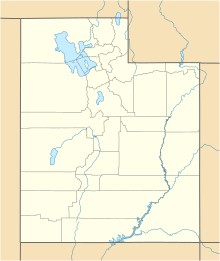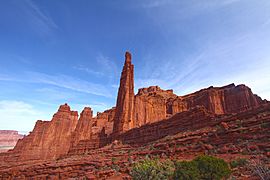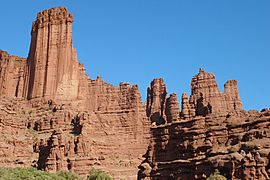Fisher Towers facts for kids
Quick facts for kids Fisher Towers |
|
|---|---|

The Fisher Towers viewed from the west at sundown
|
|
| Nearest city | Moab, Utah |
| Coordinates | 38°43′18″N 109°18′15″W / 38.7216516°N 109.3042827°W |
| Climbing type | trad and aid climbing of towers and faces |
| Height | Titan: 900 feet (270 m); Ancient Art: 400 feet (120 m) |
| Pitches | up to 7 |
| Ratings | Apart from couple moderate routes most climbs are at hard (up to A6) |
| Grades | up to IV |
| Rock type | Cutler sandstone capped with Moenkopi sandstone and caked with a stucco of red mud |
| Quantity of rock | months worth |
| Development | developed |
| Cliff aspect | south facing |
| Season | fall and spring |
| Ownership | Bureau of Land Management |
| Camping | free |
| Classic climbs |
|
| Stars | |
The Fisher Towers are amazing rock formations found near Moab, Utah in Utah. These towers are made of special red sandstone and are covered in a layer of red mud. They got their name from a miner who lived nearby in the 1880s.
People from all over the world love to visit the Fisher Towers. They are famous for their unique look, which makes them perfect for photography. They are also a very popular spot for rock climbing, with many exciting routes to explore.
Contents
Where are the Fisher Towers?
The Fisher Towers are about 16 miles (26 km) northeast of Moab, Utah. You can usually get there by taking Fisher Towers Road, which branches off Utah State Route 128. This road follows the Colorado River. From some parts of the Fisher Towers area, you can even see Castleton Tower, which is about 6 miles (9.7 km) away.
How the Towers Formed
The Towers are slowly emerging from a larger flat-topped hill called a mesa. This process takes a very long time, over millions of years! About 1,000 feet (300 m) north of the main towers, there's another tower that is still partly connected to the mesa.
The Fisher Towers are made up of three main long sections of rock, called "fins." These fins stretch from the northeast towards a desert valley in the southwest. Each fin is between 1,000 and 2,000 feet (300 and 610 m) long and they are separated by about 1,000 feet (300 m). Many individual towers on these fins have their own names.
Famous Towers to See
- The King Fisher is a large tower on the eastern side of the northernmost fin.
- Further west on the same fin is Ancient Arts. This area has four separate peaks, with the cork screw summit being the most striking. It looks like a giant corkscrew!
- The middle fin has two distinct towers: Echo Tower to the east and Cottontail to the west.
- The southernmost fin is home to Titan Tower, which is the tallest and most noticeable of the Fisher Towers.
- The Oracle is on the eastern part of the southern fin and connects back to the mesa.
There are also other interesting rock formations in the area, like the Sundial. The Cobra was another famous formation, but it collapsed in 2014. Near the parking lot, you can find Lizard Rock, a 60-foot (18 m) tall tower.
Rock Climbing Adventures
People started climbing at Fisher Towers in the early 1960s. One of the first and most famous climbs was the Finger of Fate route, which goes all the way to the top of Titan Tower. This climb is so famous that it was even included in a book called Fifty Classic Climbs of North America.
Another very popular climb is the Stolen Chimney route on the Ancient Arts tower. This route leads to the unique corkscrew-shaped summit. Pictures of this amazing corkscrew peak have been shown everywhere, even in commercials!
Fisher Towers in Movies
The Fisher Towers have appeared in movies and TV shows! They were featured in the very first scene of the movie Austin Powers in Goldmember.
Many other commercials and even scenes from famous movies have been filmed in the area around Moab, Utah, where the Fisher Towers are located. Their stunning scenery makes them a perfect backdrop for filming.
Gallery
-
View from the north with the La Sal Range in the distance







